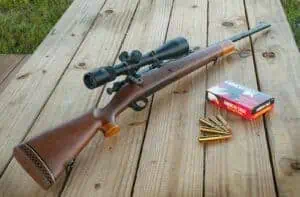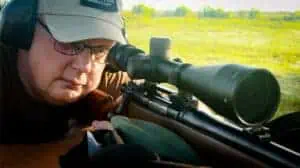The Sporterized Rifle: Turning Swords Into Plowshares
One of the most cherished guns in my collection is a M1903A3 Springfield that was sporterized by my father in-law. He changed out the stock and added buckhorn sights to turn a surplus military rifle into a sporterized rifle that is well-suited for elk hunting in the scrub pine forests of northern Arizona.
When the gun passed into my hands, I drilled and tapped the receiver to accept a scope mount, changing it from something meant for close-range hunting into a gun that can reach out to 500 yards with relative ease. That gun is just one of many, many out there that have been sporterized and turned into a unique firearm that says a lot about their owners.
Sporterized Fast Facts
- Sporterized guns were originally military firearms converted to civilian use
- Bolt action rifles are the most common sporterized guns
- Sporterizing is often done by amateur gunsmiths, with mixed results
These days, it’s common to hear politicians warning us against “weapons of war flooding our streets.” What these leaders are usually referring to is semi-automatic versions of the AK and AR platforms. These guns are not in service with any military on the planet. These politicians also fail to realize that there is a long tradition in America and other countries of turning actual “weapons of war” into guns that are ideally suited for hunting, target shooting and other activities that have always been a part of our gun culture.
Let’s start by explaining the difference between a sporterized rifle and a surplus firearm. A surplus firearm will retain the same stock, grips and accessories that it had in military service. For instance, the M1 Garand rifles and M1 Carbines that are occasionally available from the Civilian Marksmanship Program are surplus guns. Once sold, however, it is quite common to see these guns customized for use by armed citizens.
What Guns Are Commonly Sporterized?
Sporterizing didn’t start with surplus guns from WWII, and it’s not ending as supplies of guns dry up. The first wave of guns to be converted from military service into something more suitable for use as a hunting rifle were Mauser Gewehr 98 rifles leftover from World War 1. The Mauser action is renowned as one of the best bolt actions of all time, so it makes sense that sportsmen would want to adapt this gun to use as a hunting gun.
After World War II, armies all over the world switched from using bolt action rifles to semi-automatic or fully automatic rifles. This meant that there were thousands of rifles available on the surplus market, and firearms enthusiasts around the world snapped up iconic rifles such as Lee-Enfield in 303 British or the KAR98, an updated version of the WW1 Gewehr 98 in 7.92.
The Soviet Union’s penchant for turning out rifles that are tough and durable and turning them out in large numbers means there are a large amount of rifles from the Soviet era available to this day. Two of the most common are various versions of the Mosin-Nagant rifle in 7.62x54R and different varieties of the SKS semi-automatic rifle in 7.62×39.
How Do You Sporterize A Gun?
At its most simple, sporterizing a gun takes a firearm that is designed for fighting and turns into something more useful for the shooting sports. Usually this means hunting, but target shooting and just plain old plinking are also reasons why people sporterize a gun.
The most common modifications made to a gun to make it a sporterized gun are replacing the stock and adding some form of telescopic sight. Stocks are commonly replaced for a number of reasons. The original stock that came with the surplus gun might be broken and barely usable, or it may add unwanted weight to a rifle that’s meant to be carried in the field in search of game. In addition to this, the stocks on a military rifle are meant to be used by shooters of all shapes and sizes, while the custom stock on a sporterized gun can be exactly tailored to the owner.
Optics are another common upgrade on a sporterized gun. Until quite recently, telescopic sights were not in common use on the battlefield. Hunters, however, have trusted magnifying optics for decades now, and adding a scope to ensure an ethical, first-round hit on the target was and is a logical upgrade for a military gun that’s meant to be used by hunters.
Why Sporterize A Firearm?
There is a question facing gun owners of today. Why would anyone take a classic military rifle and “ruin” it by changing out the stock or drilling and tapping the receiver to add on a telescopic sight?
The fact is, things were different back then. There were millions and millions of rifles being imported into the United States, and gun owners saw that as an opportunity to turn them into inexpensive hunting rifles or something well-suited to a day at the range.
We see much the same activity today. There is a vibrant subculture in sporterizing surplus Mosin-Nagant and SKS rifles. You can find almost limitless options for changing out the stocks or adding all manner of accessories to these guns. There are even kits which convert the SKS from a gun that uses clips to a gun that can be fed from a removable magazine.
Whether or not that’s a good idea is still up for grabs.
Sporterizing Turns Your Rifle Into YOUR Rifle
In the end, the decision to sporterize a firearm is left up to the owner of the firearm itself. In my case, what was once a run of the mill rifle that was indistinguishable from thousands of other rifles is now a custom gun that is literally a family heirloom. It was handed down to me when my father in-law passed away, and one of my children will probably inherit the rifle when I leave this mortal coil. What this rifle now lacks in historical value, it more than makes up for in sentimental value.
Ultimately, the desire to make commonplace objects reflect our unique personality is what drives people to sporterize a firearm. We see that same drive in today’s booming AR-15 accessory market. Every AR-15 is in some ways an expression of the user, which is the same motivation that drives people to sporterize a Mauser or a Mosin-Nagant.
Sporterized rifles are dead. Long live the sporterized rifle.




